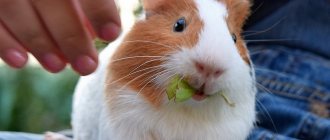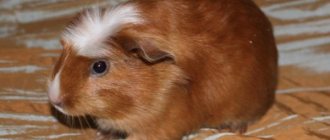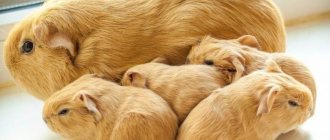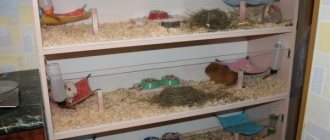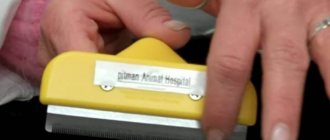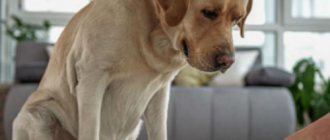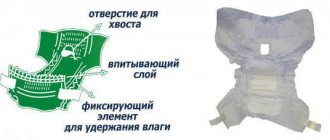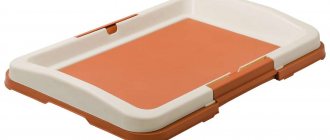What types of cages are there for guinea pigs?
You can buy a home for the animal ready-made, but it’s even better if you make the cage yourself. Regardless of whether it is purchased or homemade, the rules for keeping a rodent are the same.
Pet store sellers do not always offer exactly the models required for these rodents. You need to carefully consider this issue and know exactly what will benefit the pig.
Aquarium and terrarium
It’s interesting to observe your pet’s behavior through glass. Filler and food do not fall out of the aquarium onto the floor, the smell does not spread throughout the room, solid walls protect against whistling, which the animal can use to wake up household members in the morning. These are common arguments from sellers who offer an aquarium as a home for a pig. All of the above is true, but the sellers are disingenuous, keeping silent about how hard life is for a rodent in an aquarium, and how short its life is.
No matter what size the aquarium is, normal ventilation will not be achieved, since high solid sides contribute to air stagnation. It heats up, the concentration of carbon dioxide increases, and there is a lack of clean air. Ammonia vapors from the animal's toilet will constantly irritate the pet's respiratory tract. These factors lead to the development of respiratory tract diseases, weaken the immune system, and reduce appetite. The terrarium has a similar effect on the animal.
An owner who does not want his pet to suffer will never put him in an aquarium.
Dune
A dune is a plastic box, similar in structure to a terrarium. Consists of two parts: a tray and transparent walls. For ventilation there is a lattice door in the ceiling.
This is reliable protection from the cold, there is no dirt on the floor, and it is convenient to observe the life of a rodent. But you can’t achieve good ventilation in a dune either. Therefore, all the negative aspects, like in an aquarium, remain.
It is justified to purchase Dune for hairless pigs to eliminate the risk of hypothermia.
You can purchase a dune to keep young animals until their immunity is strengthened.
For chinchillas and degus
Tall trellis structures for chinchillas and degus feature numerous levels and climbing features. The pig does not know how to cling to fences with its paws. Even a small height is dangerous for her.
Pigs should not buy a two-story cage designed for chinchillas. Animals will not appreciate such housing.
Display cabinets
It is convenient to use fences in the form of display cases for guinea pigs. Most often they are made from old bookcases with their own hands.
It is a pleasure to arrange such a home for an animal. The display cases are made multi-level, but the transitions are arranged in such a way that the pig does not fall.
To provide the rack with ventilation, the back and side walls are made perforated. It turns out to be a good option for keeping pigs.
Lattice cage
Slatted housing is similar to those used for keeping rabbits. The high sides of the plastic tray protect against the scattering of sawdust. Cleaning such a home is easy. The area with lattice walls and ceiling is provided with good ventilation.
The rods are used to attach accessories to them - a drinking bowl, a hammock.
A lattice cage is an ideal option, provided that it has a large area or a stationary enclosure is equipped nearby.
Aviaries
No matter how good the cage is, it will never be able to fully satisfy the pig's needs for active walks.
It is not always possible to devote a lot of time to your pet, arranging walks around the room. The way out is an enclosure for a guinea pig. It can be bought ready-made or built from scrap materials. It is a fence made of plastic or metal mesh. If possible, she is placed next to the cage. Or they make an external one for a balcony or yard.
Inside the enclosure there are a minimum of items that may be useful for the rodent to play with. The whole emphasis is on expanding the space. If the enclosure is very large, it will be equipped with everything necessary. In this case, you can buy a small cage.
The fenced area should be clean and spacious. The wider and longer it is, the better.
Types of enclosures for pigs
In the summer, experts recommend releasing pigs onto the grass, giving them a little freedom. Ideally, summer residents will be able to do this by taking a portable enclosure with them. If you don’t have money for an enclosure, you can drive small pegs into the ground and stretch a tight mesh. Despite the simplicity of such a structure, an enclosure of this type will not protect your pet from uninvited guests. The greatest danger comes from cats, dogs and birds of prey flying past. If the pig is in an enclosure without a cover on top, it must be under constant supervision.
Enclosures have different internal designs. For the convenience of the animal, you can build tunnels and indoor labyrinths where it can hide from danger. Additions are most often constructed from balsa wood or oak. Bridges can be made from tree bark; they increase the endurance of animals. In the pen itself, you can place additional equipment in the form of toys and other accessories at the owner’s discretion. The floor of the enclosure should be equipped with linoleum or absorbent film. Pieces of an old rug will do. Do not forget that the cage needs periodic cleaning.
Do not give your animal plastic objects, feeders or drinking bowls. Your pet may chew on such objects and injure themselves on the edges of the bitten plastic. Walking for your pet can be organized using a purchased ladder.
Country type enclosure
In the summer, many owners take their pet with them to the dacha in the summer. To make the animal comfortable, you can build a special country-type enclosure. The enclosure is built according to the previously agreed method - stakes are driven into the ground and the net is stretched. You can also pull it on top for greater safety for your pet.
An aviary of a more reliable design is usually made of solid wood. From the outside it looks like a box without a top. It can be attached if you want to protect your pet from uninvited guests like birds of prey, but then you should take care of ventilation. It is distinguished by its spaciousness and proper insulation using special means. The bottom is retractable, which ensures comfortable care by the owners. The surface of the box should be treated a couple of weeks before departure with a protective agent that will prevent rotting and the appearance of various bacteria and putrefaction, and will also protect from moisture.
It is important to remember that you only need to treat the outer part of the enclosure, since the pig may begin to chew on the wood and be poisoned by chemicals. Usually the pen is left in the shade of trees, but if it starts to rain, the pet should be brought into the house
Guinea pig cage size
To equip a guinea pig cage with everything necessary, you need to maintain the dimensions. Rodents have a genetic need to be active. In the wild, they forage for food, covering vast distances. Thanks to activity, they keep their body in shape. In a cramped home, the animal will quickly gain excess weight.
The cell size is calculated so that there is approximately 0.7 square meters per individual. meters of area. The ceiling should allow the animal to stand on its hind legs. Not less than 0.5 sq. meters are added for the second rodent.
In a country house it is easier to provide the animal with space. For this purpose, enclosures are set up in the fresh air during the warm season. If the dimensions are limited to the standard dimensions of 600x400 mm, you should often give the rodent the opportunity to walk around the apartment. The rodent should not be left alone during walks.
Food
A healthy diet will prolong the life and improve the health of your pet. Remember the correct diet of the animal:
- hay – 60%;
- vegetable and fruit components, greens – 30%;
- dry food – 10%.
The main product on the animal’s menu is hay. It forms healthy digestion for your pet and supplies it with all the necessary substances and vitamins. The most useful is considered to be hay made from cereals and beans, clover, alfalfa, and nettle. Hay is purchased or prepared independently.
Guinea pigs are primarily herbivores, so the menu should include seasonal fruits and vegetables. Pieces that are not eaten before the next feeding are thrown away. Your pet's daily diet should include at least 5 types of vegetables and herbs. The animal is offered sprouted grains and seeds, branches of trees and shrubs along with leaves and flowers (acacia, birch, maple, poplar). Remember that many plants, such as lilacs, and most indoor flowers are poisonous to guinea pigs.
Design
Large cages should be comfortable and safe. Multi-level homes with ladders in the form of rungs are dangerous for pets. The paws instantly get stuck between the bars.
Recommendations regarding cage designs are as follows:
- One-story dwellings are much more convenient for animals.
- The animal must climb onto existing elevations (for example, onto the roof of a house) along a ramp.
- The pallet must have reliable fastenings so that it does not fall off during transportation. At the same time, it should be conveniently removable for cleaning.
- The optimal distance between the rods is 25 mm.
To make the animal easy to remove, you need to provide a wide door or a removable roof. The second option is preferable.
Poor nutrition
Many companies produce food for guinea pigs, but they are not always of high quality. They can be produced from contaminated grain and various wastes. Rid your pet of cheap grain food. In addition, owners should be aware that the following should be excluded from the guinea pigs' diet: nuts, grains, sugar and honey.
Among the foods we can recommend are the products “Little Van Green Valley” and “Krispy Muesli”. And, of course, succulent food. These include carrots, bell peppers, tomatoes, apples, cucumbers, beets and celery. It must be remembered that the majority of the pig's diet should be hay.
Capricorn and 3 other zodiac signs whose glass is always half empty
Serebryakov returned to Russia. Shukshina believes that he should not have left
Apple does not leave the market in Russia, agreeing to install Russian software
Many companies produce it, but experts consider the product to be the best - the branches in it are long, without rot, rodents eat it with pleasure. Another mistake that owners make is related to water. She, like hay, must be in the cage at all times, clean and fresh.
Never give salt rocks or sweet sticks to your pigs. At best, they will refuse them, and at worst, they will eat this sugar-and-honey muesli and get sick. If you want to pamper your pet, treat him to an apple or pumpkin.
Materials
A high-quality cage for a guinea pig is not cheap; the price depends not only on the size, but also on the material used. The following are in demand:
- Stainless steel metal rods. Durable and resistant to contact with detergents material. Usually comes paired with a plastic tray.
- Plexiglas walls are quite safe and hygienic, but quickly lose their attractiveness, as they are easy to scratch.
- Wooden environmentally friendly. But they become saturated with moisture and odors. The animals gnaw them.
You can lay a tarpaulin in a wooden cage on the floor. It is waterproof and easy to clean.
When choosing a material for making a home for a pet, take into account that he likes to chew on everything around him. There are types of plastic that are resistant to rodent teeth.
Toys
Toys are added for interest. Paper bags, crumpled paper, cardboard boxes, balls, wooden blocks, hard plastic cat and rabbit toys, fleece tunnels, small fleece blankets and hanging bird toys may be of interest to your guinea pigs.
Just make sure there are no small parts that could come off or be chewed off and swallowed.
Wheels and exercise balls are not recommended; Many experts believe that guinea pigs' bodies are not designed for this type of exercise and the risk of injury is too great. Try to do the exercises using other means.
Popular manufacturers
The quality and cost of a guinea pig cage varies from manufacturer to manufacturer.
Triol
Products for rodents from this Russian company are sold at low prices. Triol wire cells are large and functional. The high-sided trays are made of beautiful plastic. The door is located on the ceiling. Some models have removable slatted floors, which protect the rodent from dampness.
Convenient fasteners allow you to quickly assemble and disassemble the cage. The grille is coated with a durable coloring compound.
Ferplast
The Italian company ferplast produces comfortable housing for animals made of plastic, metal and wood.
There are models on stands with a removable bottom. This is convenient in summer for installation in the yard. Additional compartments are available to increase space. The two-story cages are equipped with a ramp. You can find Ferplast products where folding walls act as doors and ramp houses. The rods are coated with a compound that is resistant to the teeth of pigs.
Savic
Wire models with pallets made in Belgium are made of durable colored plastic. Convenient fastening elements, plastic is easy to wash. The walls fold back, so you can clean the cage from any side.
Dune containers are equipped with a large mesh door on the ceiling to allow air to enter. It is convenient to load the feeder with food and take out the animal.
Imac
Durable single-level structures from the Italian manufacturer are designed specifically for guinea pigs. They have a large plastic base and a lattice top. For their manufacture, materials of excellent quality were used. The animals will love the shelf with a safe ramp. The ceiling and side walls are equipped with folding doors. If you are satisfied with the price of a cage from this company, you can safely buy it and not worry about the comfort of your pet.
Midwest
An interesting model of the Guinea habitat plus cage-aviary is offered to rodent lovers by an American company. The canvas tray is equipped with Velcro, making it easy to remove for cleaning and washing.
The midwest model can be quickly transformed into an aviary for walking. A connection between two cells is provided. If you disassemble the ceiling, you will get additional sections for the enclosure or internal partitions. All parts are easy to disassemble and fold.
Exercise Handles
If your enclosure doesn't have plenty of space for exercise, your guinea pigs should be given extra space.
A portable wire cage (you can make your own or buy ones made specifically for small animals or dogs) can be used as a pen for guinea pigs and keep them from getting into trouble (climbing under furniture, chewing wires, etc.).
Your guinea pigs can enjoy being outside in warm weather - a wire cage (fully enclosed to protect the guinea pigs) placed on the lawn is a nice change of scenery.
Only do this if you are not using pesticides or fertilizers on your lawn. Water and shade should be available at all times when they are outside.
What do guinea pigs eat?
How to make it yourself
A homemade cage will save money. If you show your imagination, such a home will not only be comfortable and economical, but also aesthetically beautiful.
Home craftsmen use thick construction cardboard, wood, plywood, and plexiglass. To make the frame you will need wooden blocks. If you use old furniture, the price will be even lower.
To ensure good ventilation, you cannot do without a metal mesh with cells of 3 cm for an adult animal and no more than 1 cm for cubs.
Tools for work you may need:
- Roulette (large ruler);
- level;
- wood saw or hacksaw;
- jigsaw;
- metal scissors for mesh;
- screwdriver (drill);
- knife for plastic.
It is necessary to prepare wood glue, nails, screws, door fittings (hinges, latches). Sometimes they make sliding doors. Guide skids are purchased for them.
Manufacturing step by step:
- Choose a ready-made one or make a cell drawing.
- Prepare all materials.
- Transfer the drawing to wood or plywood.
- Cut out the parts using a jigsaw or hacksaw.
- Make a rectangular frame base from four bars.
- Nail a sheet of plywood or wood onto the base on top of the frame (this is the floor of the first floor).
- Glue a sheet of plastic or tarpaulin to the tree to protect it from odors and moisture.
- Screw the vertical and then horizontal frame guides.
- Attach the back and side walls of the cage.
- Attach sliding runners for the door or hinge to the façade slats.
- In the side walls, if they are made of plywood or wood, windows are cut out and covered with mesh.
The roof is done last. You can choose any shape, depending on the chosen design. It is best if the roof is retractable or removable, made of transparent plastic or metal mesh on a wooden frame.
When making a two-tier model, a small hole is cut out in the floor of the second floor, where a ramp is placed. All elevations and shelves are equipped with convenient ramps made of thin boards, onto which a strip is glued at small intervals.
The wooden blocks that are left after the cage is made can be placed in the cage as toys in different configurations.
How to properly arrange your home
Having decided on the choice of house, you can begin to arrange it. It is necessary to place everything necessary to provide the basic needs of the guinea pig.
The room must have:
- drinking bowl;
- feeder;
- tray with filler;
- bedding made of tarpaulin or sawdust.
To make your pet's life interesting and varied, you can place a variety of accessories in its home. For movement, wooden shelves connected by a ramp can be attached to the walls.
We recommend learning how and what to play with guinea pigs.
You can also place a wooden mini-shelter in a secluded corner. The animal will rest and sleep in it. All sorts of toys will not be superfluous. But at the same time they must be made of organic materials. Plastic accessories for rodents are not allowed.
Where to place the cage
Regardless of whether a pig’s cage is expensive or cheap, there are certain rules that you need to know when choosing a placement location:
- The cage should be placed away from drafts;
- the place should be quiet;
- UV rays should not reach the rodent;
- heaters and heating radiators near the cage are not allowed;
- the animal will not be comfortable in a dark and damp corner;
- the air temperature in the room should not be more than 24 C;
- a stand is used for the cage, so it will be more convenient for the rodent to observe the household from an elevated position.
The principle of placement is this: you need to give the pet the opportunity to plunge into the thick of the events that are happening in the room. At the same time, there must be protection from unfavorable factors such as drafts, noise and heat.
Choosing the right pet store
Let's imagine this situation. You walk into your local pet store and see an adorable guinea pig that makes your heart melt, and then you notice that the cute animal is huddled in a small glass aquarium with four other rodents.
You, of course, will think that by buying the animal you like, you will save it from such maintenance. In fact, your best bet is to leave this store that treats animals this way. Supporting such outlets is a common mistake of novice owners.
As a rule, to keep rodents they use small aquariums that are not suitable for keeping guinea pigs, as well as other rodents, which are small even for one animal, and they accommodate up to five “tenants” at a time. Naturally, in this case the pigs may not be in the best condition.
Colorful March. Brown snow fell in Colorado (USA)
Many lines and two branches: we read the marriage lines under the little finger
“Let the children grow up first!”: why people put off apartment renovations
Find a large pet store where animals are kept in decent conditions and have a veterinarian who can advise you on how to keep such a pet.
Arrangement of the cage
A rodent's home is multifunctional. The arrangement of the cage includes items that will be needed not only for food and rest, but also for active entertainment.
To avoid fights, each pig is given a house. They can be purchased plastic or homemade wooden. The flat roof will serve as an observation post. Instead of stairs, a ramp is installed, which is securely fixed.
The animal's dining room is equipped with feeders for dry grass and grain, and a drinking bowl. It is preferable to install a plastic tank with a tube with a ball valve at the end.
Feeders should be safe: without edges or edges, food residues can be easily cleaned off. The best models are plastic, ceramic, stainless steel, and enameled. Senniki are made from mesh or fabric; they buy ready-made plastic ones that are attached to the walls.
Animals will love a hammock, a soft bed, toys made from natural materials, and a labyrinth with several holes. A hammock can be easily made from a regular towel. The space should not be cluttered; all these attributes are installed if space allows. Free space is also an element of the game where the animal can run and jump.
The rodent loves to roll an ordinary tennis or hard rubber ball. You need to choose a large ball so that it is difficult to chew it.
The animal can try any objects that are used to furnish the cage. Under no circumstances should glass figures be left in the cage. Even a very small chip can cause a dangerous wound to your pig.
To prevent the animal from wanting to spoil things, there should always be dry grass and branches of fruit trees in the hay barn.
Pigs are very shy, but at the same time they easily make contact with other pets. It is possible that the rodent will share a bed in the enclosure with a kitten or puppy.
What types of enclosures are there?
Enclosures can have different “interiors”. You can make some kind of tunnels and pipes so that the animal can run and hide through them. This is often made from cork oak. Guinea pigs enjoy a variety of bridges. They can be made from bark. Ceramic toys and wicker baskets can be placed in the pen.
It is better to place an absorbent diaper on the floor in the enclosure. Old linoleum will do. You can throw on pieces of an old natural rug. Don’t forget to sanitize all this in a timely manner.
You can organize a walk for your guinea pig using a fence purchased from a pet store.
